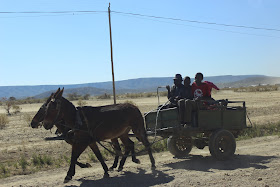After a 36-hour flight (including layovers) our daughter, Kelda, arrived safely in Namibia on July 19th. We didn't give her much time to rest as we immediately embarked on an 8-day excursion through northern Namibia, returning to Windhoek on July 20th. Including our trips into Etosha National Park, we probably traveled a total of 2,500 km. So, it was a lot of driving but a really fascinating journey. The basic route we took is shown below.

As you travel north and west of Etosha National Park, you enter the more traditional tribal areas including the Nama, Herero, Himba, Oshiwambo and others. The poverty level increased significantly with many of the people still living in traditional villages and housing where most were surviving on subsistence level farming and ranching. People were dressed in their native clothing and the main streets were full of people walking, roadside markets, etc. An entirely different atmosphere than in Windhoek and more like you envision Africa to be from National Geographic.
 |
| Traditional Oshiwambo Village |
 |
| Roadside Market in Ondangwa |
 |
| Roadside Market - Woman Wearing Traditional Herero Clothes |
 |
| Market in Opuwo - Women Wearing Traditional Himba Clothing |
We passed many herds of goats and cattle and frequently had to stop and wait for livestock to cross the road. The land is stilled farmed and ranched communally within the tribes so there are no fences to keep the livestock off the roads.
The landscape changes to a wide, flat delta flood plain dotted with Makalani Palms and Mopane Trees. There are also lots of small water holes. During the rainy season, the delta is flooded and fish is washed into the water holes where they are fished by the locals using nets. Numerous vendors along the roadside where selling fish.
 |
| Delta with Makalani Palms and Mopane Trees |
So, we experienced lots of traditional culture. We also visited Etosha National Park and saw lots of wildlife. Unfortunately, we didn't see any predators.
 |
| Jostling Elephants |
 |
| Saddle Billed Stork |
It was a very good trip and it is nice to have Kelda here. This is just a brief summary and we will have multiple posts that will cover more specific details from the trip.





















































